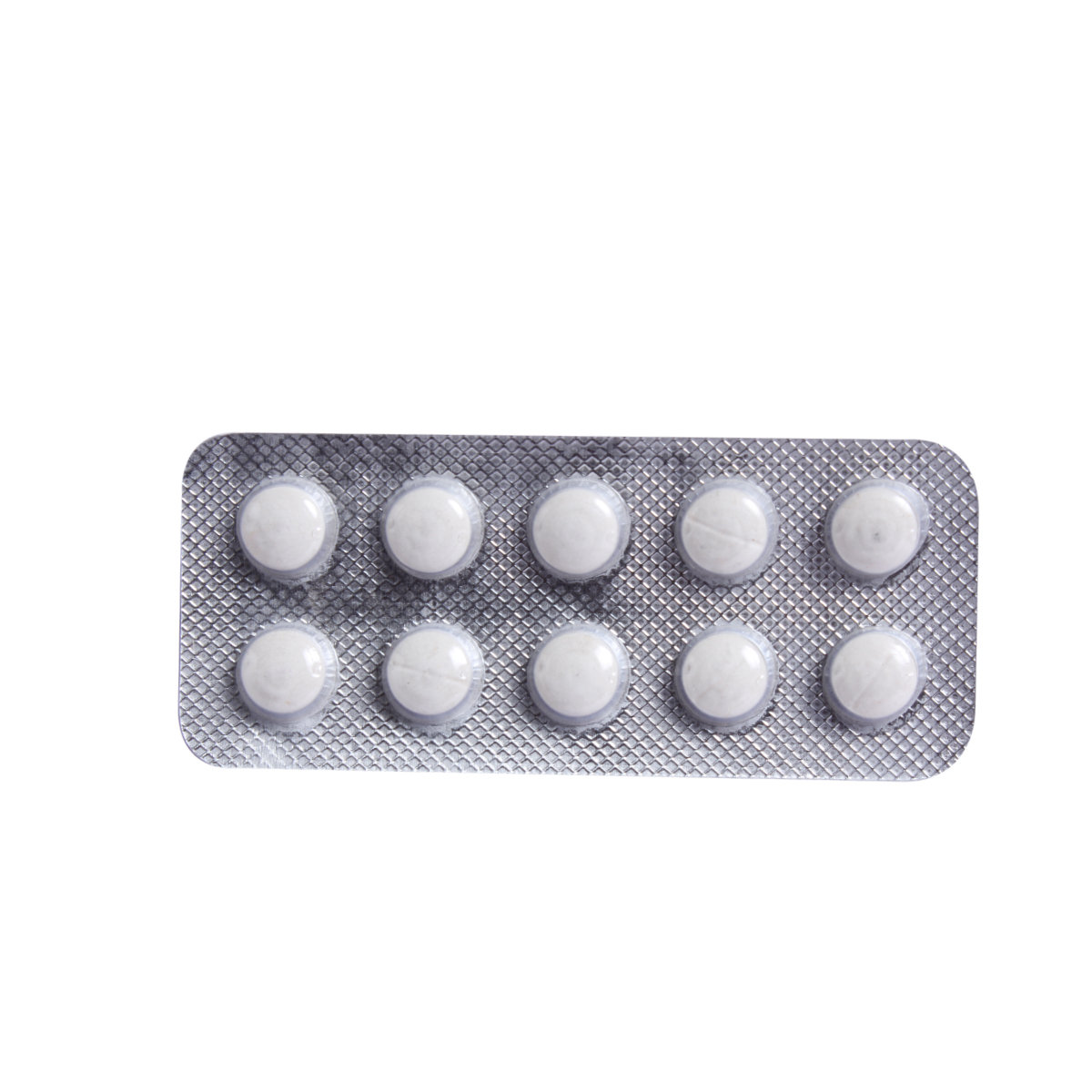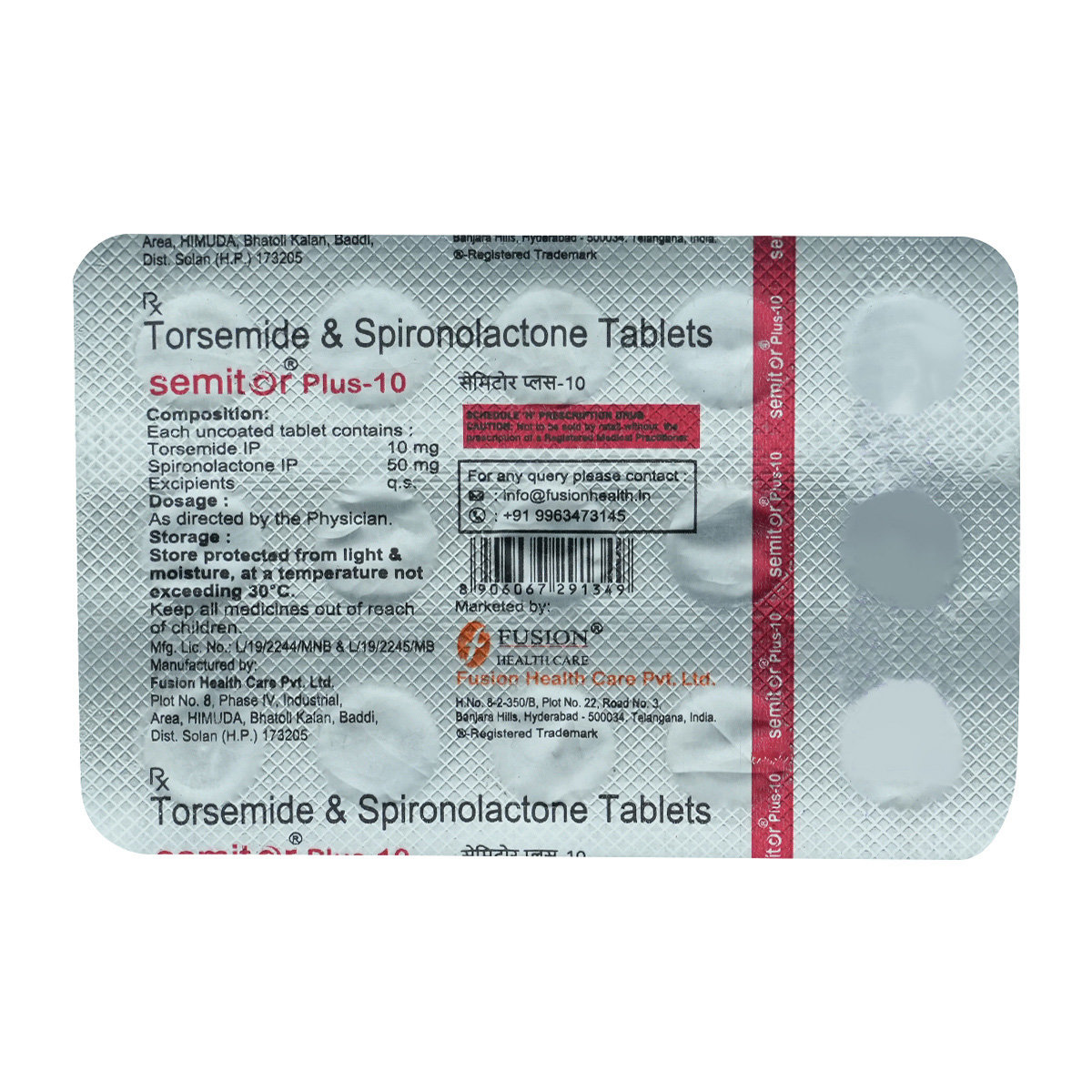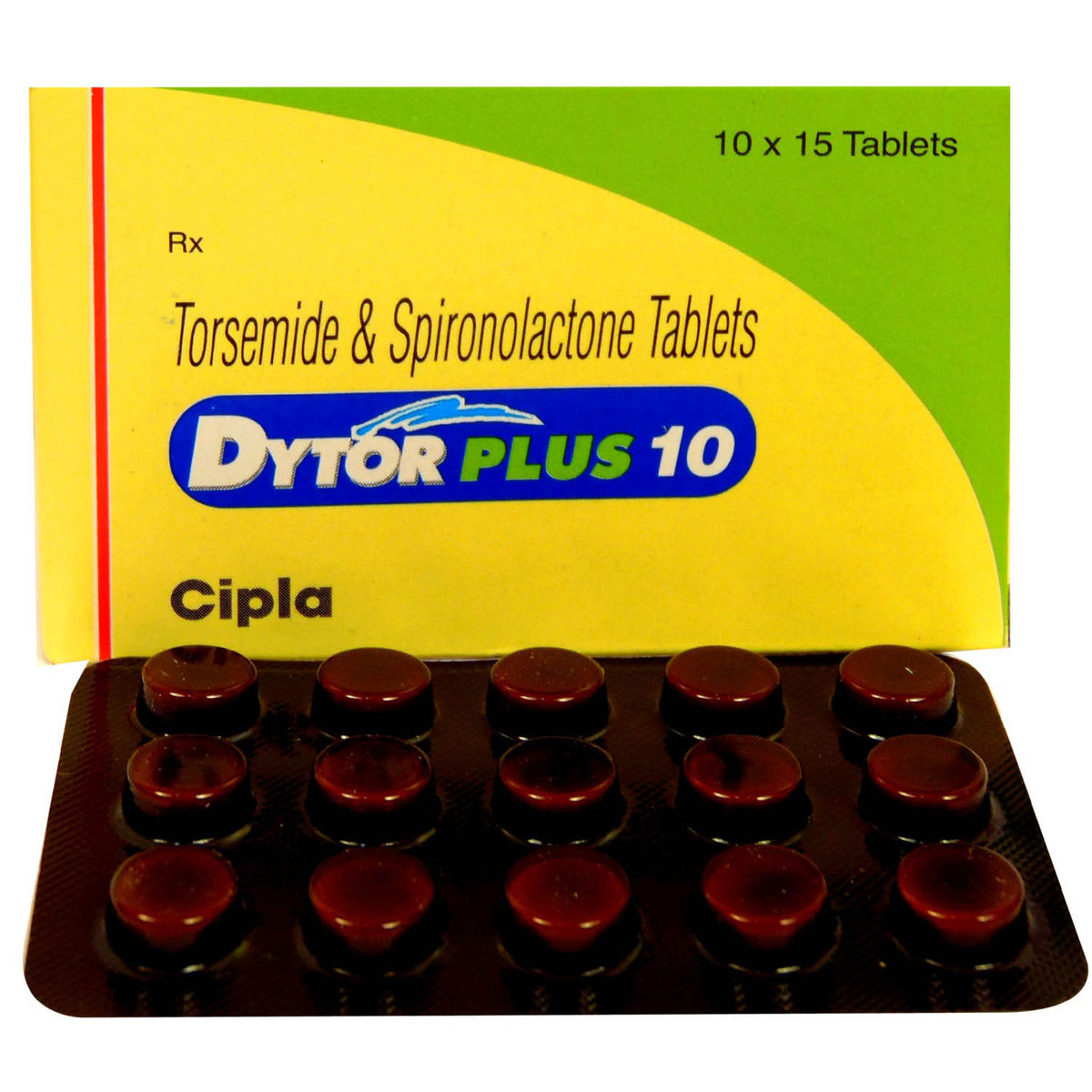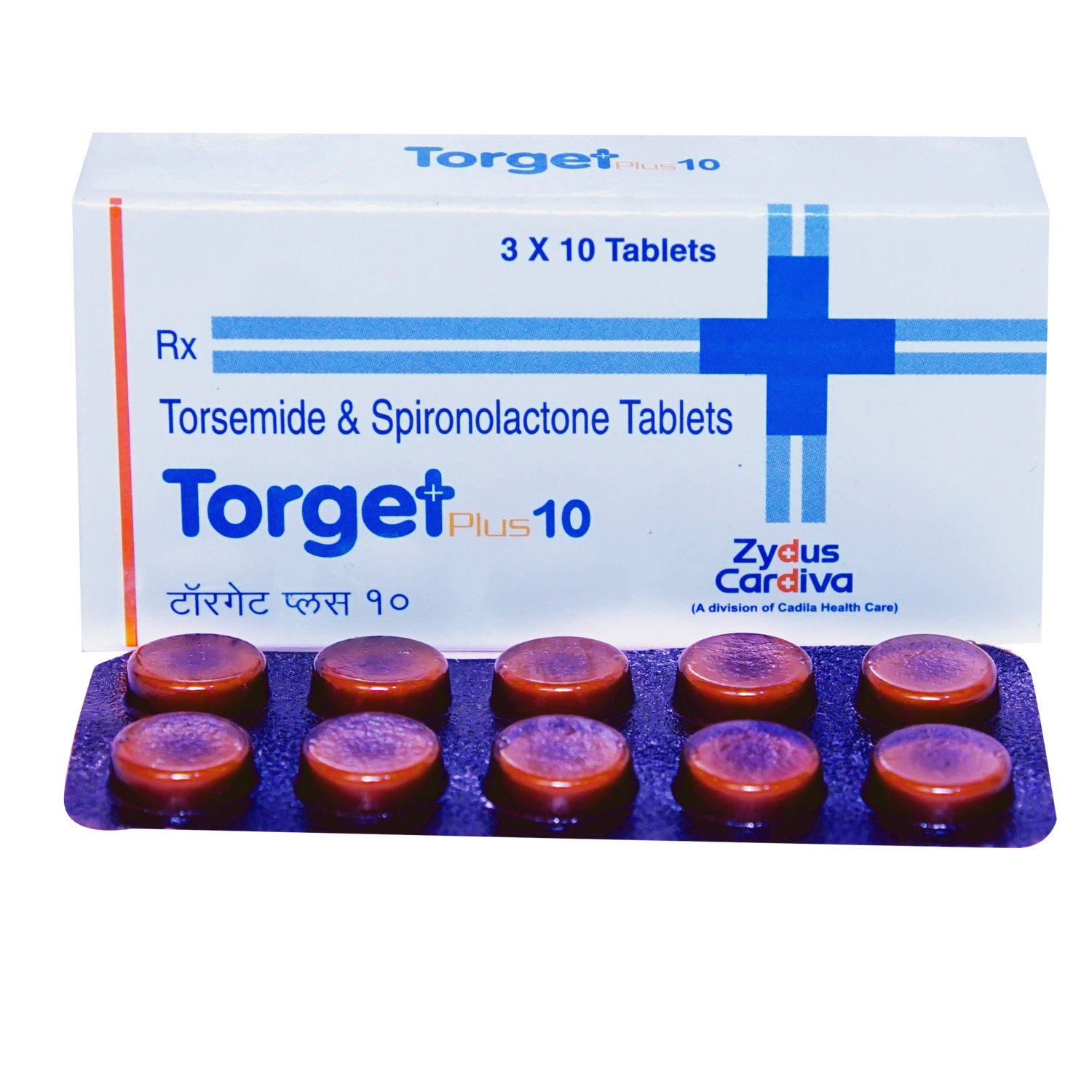Jbtor Plus Tablet 10's
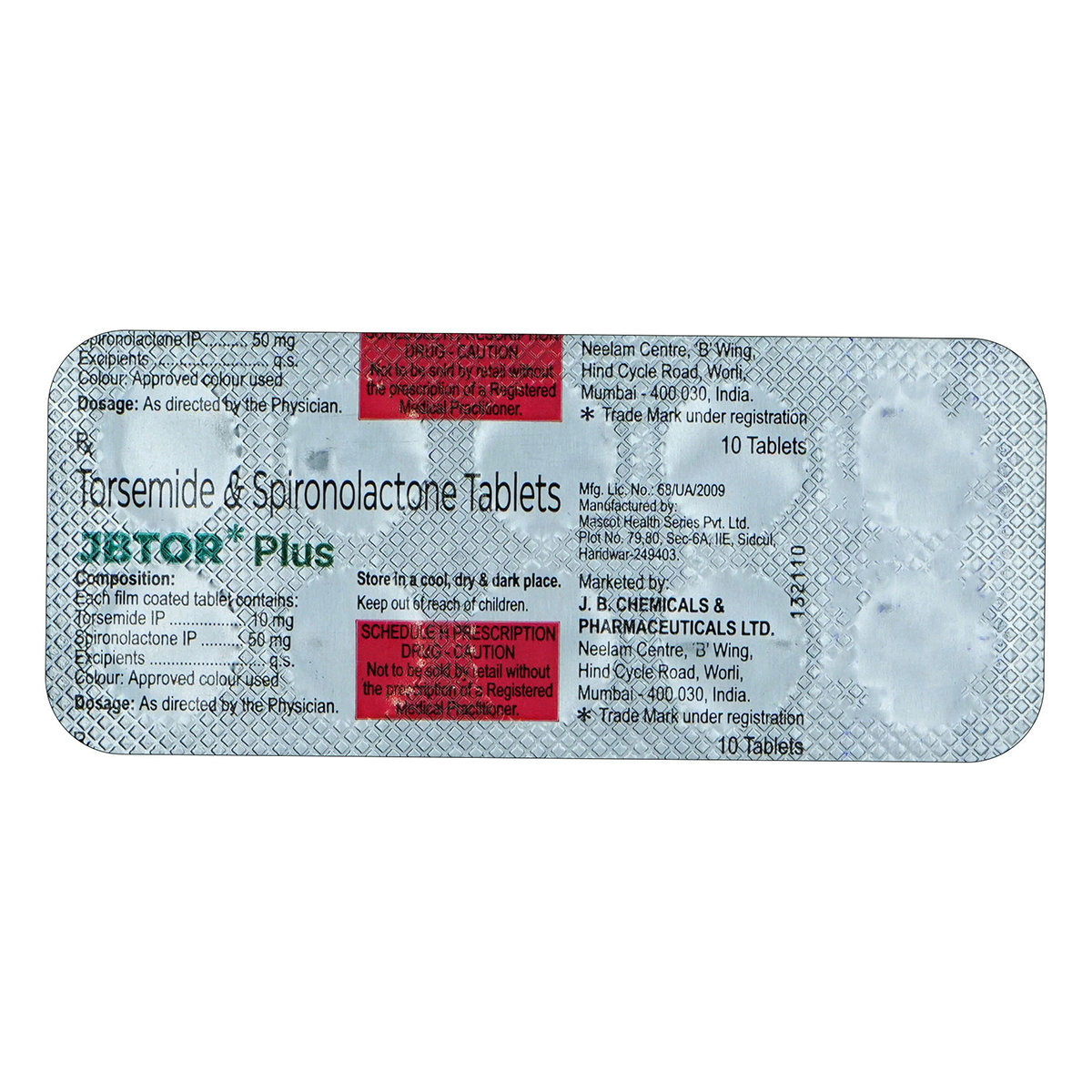
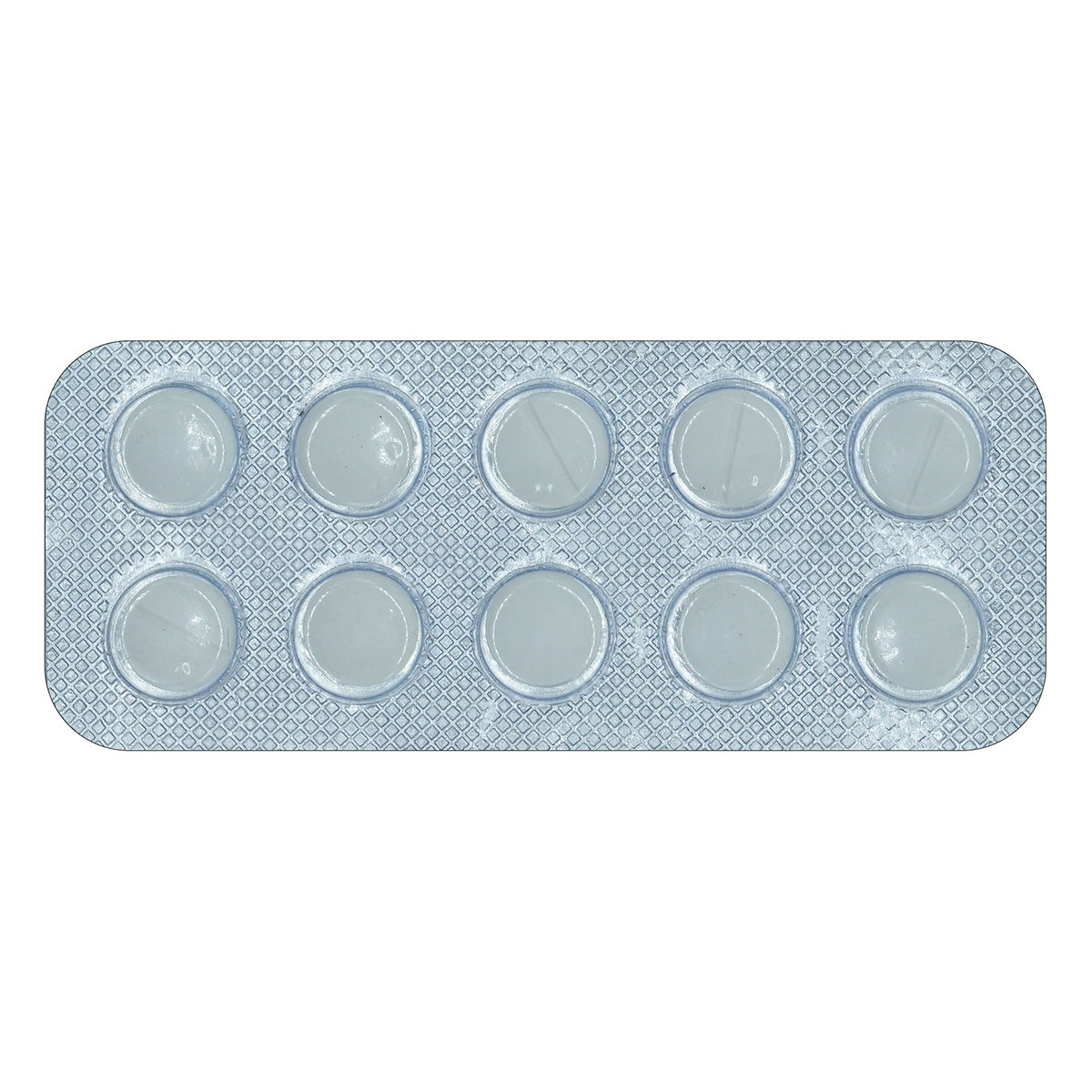


MRP ₹67
(Inclusive of all Taxes)
₹10.1 Cashback (15%)
Provide Delivery Location
Online payment accepted
 Prescription drug
Prescription drugWhats That
Composition :
Manufacturer/Marketer :
Consume Type :
Expires on or after :
Return Policy :
About Jbtor Plus Tablet
Jbtor Plus Tablet belongs to a class of medicine called 'diuretics' (water pills), primarily used to remove excess water from the body. It also maintains the bloodstream's potassium level and prevents hypertension (high blood pressure due to oedema (fluid retention). Oedema or fluid overload is associated with pulmonary hypertension (high blood pressure in the lung) or heart failure (irregular heart pumping). Leg swelling is the main characteristic of oedema, accompanied by shortness of breath, chest pain (angina), abnormal heart rhythms (arrhythmia) and swelling in other hands or abdomen areas.
Jbtor Plus Tablet is a combination of medication containing Spirolactone and Torsemide. Both spironolactone and torsemide are diuretics and are prescribed for the treatment of resistant oedema (fluid overload) associated with pulmonary hypertension (high blood pressure in the lungs), heart failure, and hepatic cirrhosis (chronic liver damage). Jbtor Plus Tablet works by increasing the amount of urine that is passed out from the kidneys. It effectively reduces excess fluid levels in the body and treats oedema (swelling) associated with heart, liver, kidney or lung disease. This reduces the heart's workload and makes the heart more efficient at pumping blood throughout the body. Thus, it also helps lower high blood pressure, reducing the chances of any future heart attack, stroke or angina (chest pain) in the future.
You can take Jbtor Plus Tablet with food or without food with a glass of water. Take it preferably in the daytime to avoid frequent urination in the nighttime. Do not chew, crush or break it. Your doctor will advise you how often you take Jbtor Plus Tablet based on your medical condition. In some cases, you may experience dehydration, electrolyte disturbances (potassium and sodium), headache, nausea, or dizziness. Most of these side effects of Jbtor Plus Tablet do not require medical attention and gradually resolve over time. However, if the side effects are persistent, reach out to your doctor.
Try not to stop taking Jbtor Plus Tablet of your own as doing so may raise your blood pressure, thereby increasing the risk of getting heart diseases and stroke. Inform your doctor if you are suffering from any kidney, liver or heart disease. If you are pregnant or breastfeeding, please tell your doctor so that the dosage of Jbtor Plus Tablet can be prescribed accordingly. Please tell your doctor if you are taking any other medicines or are allergic to Jbtor Plus Tablet . Reducing the amount of table salt (sodium chloride) in your food often relieves the body's swelling.
Uses of Jbtor Plus Tablet
Directions for Use
Key Benefits
Jbtor Plus Tablet is a combination of medication containing Spirolactone and Torsemide. Both spironolactone and torsemide are diuretics and are prescribed for the treatment of resistant oedema (fluid overload) associated with pulmonary hypertension (high blood pressure in the lungs), heart failure and hepatic cirrhosis (chronic liver damage). Jbtor Plus Tablet works by increasing the amount of urine that is passed out from the kidneys. It effectively reduces excess fluid levels in the body and treats oedema (swelling) associated with heart, liver, kidney or lung disease. This reduces the heart's workload and makes the heart more efficient at pumping blood throughout the body. Thus, it also helps lower high blood pressure, reducing the chances of any future heart attack, stroke or angina (chest pain) in the future.
Storage
- Regular activity including cardio and weightlifting can help in weight loss and breast tissue reduction.
- Limit alcohol intake to lower your chances of gynecomastia and hormonal changes.
- Eat a balanced diet and avoid foods high in estrogen-like compounds.
- Follow your doctor's instructions take medication consistently to reduce breast enlargement and do not stop taking medication on your own.
- Limit fruit intake to two servings a day, choose a low-potassium options like apples and strawberries.
- Restrict starchy vegetables like potatoes and pumpkin to half a cup daily.
- Avoid or limit foods like tomato products, high-bran cereals, and salty or sugary snacks.
- Limit dairy products to 200g of yoghurt or 300ml of milk per day.
- Consume controlled amounts of salt to raise sodium levels.
- Eat fresh fruits like apples, berries, oranges, mangoes, and bananas.
- Include fresh vegetables like broccoli, sweet potatoes, beets, okra, spinach, peppers, carrots, and edamame.
- Choose frozen vegetables without added butter or sauce.
- Drink electrolyte beverages like sports drinks or electrolyte solutions to replenish sodium and other electrolytes.
- Avoid excessive salt intake, but allow for controlled increases as needed.
- Monitor and manage underlying health conditions that may contribute to hyponatremia.
- Eat a healthy balanced diet.
- Reduce stress with relaxation techniques such as yoga or meditation.
- Keep track of your menstrual cycle any irregularities.
- Have regular check ups to exclude other health problems.
- Exercise but do not exercise to the extent of overheating.
- Hydrate well, eat well (particularly iron and vitamins).
- If you experience a lack of energy due to liver conditions, consult your doctor to determine the underlying cause and further management.
- Rest well; get enough sleep.
- Manage stress with yoga and meditation.
- Limit alcohol and caffeine instead drink plenty of water.
- Physical activities like walking or jogging might help boost energy and make you feel less tired.
- Change positions or take a break from activity to relieve symptoms.
- Avoid postures that put a lot of pressure on just one area of the body.
- If you have vitamin deficiency, take supplements or change your diet.
- Exercise regularly like cycling, walking or swimming.
- Avoid sitting with your legs crossed.
- Clench and unclench your fists and wiggle your toes.
- Massage the affected area.
- Inform your doctor about the nausea and discuss possible alternatives to the medication or adjustments to the dosage.
- Divide your daily food intake into smaller, more frequent meals to reduce nausea.
- Opt for bland, easily digestible foods like crackers, toast, plain rice, bananas, and applesauce.
- Avoid certain foods that can trigger nausea, such as fatty, greasy, spicy, and smelly foods.
- Drink plenty of fluids, such as water, clear broth, or electrolyte-rich beverages like coconut water or sports drinks.
- Use ginger (tea, ale, or candies) to help relieve nausea.
- Get adequate rest and also avoid strenuous activities that can worsen nausea.
- Talk to your doctor about taking anti-nausea medication if your nausea is severe.
- Record when your nausea occurs, what triggers it, and what provides relief to help you identify patterns and manage your symptoms more effectively.
Drug Warnings
Jbtor Plus Tablet should not be given to the people allergic to Jbtor Plus Tablet , have low blood pressure (less than 90 mm of Hg), have had a heart attack, kidney disease (with creatinine clearance less than 30 mL/min), liver disease, pregnant women, or planning to get pregnant and breastfeeding women. Besides this, it is contraindicated in low blood pressure (hypotension), cardiogenic shock (sudden stopping of blood flow to the heart), and aortic stenosis (heart valve problem). Jbtor Plus Tablet can pass into breast milk, but its effect on the baby is unknown, so it is better to tell your doctor if you are taking Jbtor Plus Tablet and breastfeeding. Dehydration with electrolyte and acid-base disturbances must be corrected before using Jbtor Plus Tablet . Do not take any extra potassium supplements or potassium-rich foods such as bananas and broccoli with Jbtor Plus Tablet , as it may lead to an excessive increase in blood potassium level (hyperkalemia). Please take Jbtor Plus Tablet at least 4 hours before sleeping to avoid frequent urination at night.
Drug-Drug Interactions
Drug-Drug Interactions
Login/Sign Up
Co-administration of Jbtor Plus Tablet can make Desmopressin may increase the risk of hyponatremia (low levels of salt in the blood).
How to manage the interaction:
If you have to use Desmopressin and Jbtor Plus Tablet together, a doctor may adjust the dose or monitor you more frequently to safely use both medications. However, if you experience loss of appetite, headache, nausea, vomiting, lethargy (very tired), irritability, difficulty concentrating, weakness, unsteadiness, memory impairment, confusion, muscle spasm, decreased urination, and/or sudden weight gain, contact your doctor immediately as these may be symptoms of water intoxication (water poisoning) and hyponatremia (low levels of salt in the blood). Do not discontinue the medication without consulting a doctor.
Coadministration of Amiloride with Jbtor Plus Tablet may increase potassium levels in the blood.
How to manage the interaction:
Taking Amiloride with Jbtor Plus Tablet is not recommended as it can result in an interaction, it can be taken if a doctor has advised it. However, consult the doctor if you experience nausea, vomiting, weakness, confusion, tingling in your hands and feet, feelings of heaviness in your legs, a weak pulse, or a slow or irregular heartbeat. It is important to maintain proper fluid intake while taking these medications. Do not stop taking any medication without doctor's advice.
Combining Eplerenone with Spiranolactone may significantly increase potassium levels in the blood which can lead to kidney issues and irregular heart rhythm.
How to manage the interaction:
Although there is a possible interaction between Jbtor Plus Tablet and eplerenone, it is not recommended as it can lead to an interaction. You can take these medicines if prescribed by a doctor. Consult a doctor if you experience nausea, vomiting, weakness, confusion, tingling in your hands and feet, feelings of heaviness in your legs, a weak pulse, or an irregular heartbeat. It is essential to maintain proper fluid intake while taking these medications. Do not discontinue any medications without a doctor's advice.
Co-administration of tizanidine with Jbtor Plus Tablet may result in low blood pressure.
How to manage the interaction:
Although taking tizanidine and Jbtor Plus Tablet together can possibly result in an interaction, it can be taken if your doctor has advised it. However, if you experience symptoms such as blurred vision, dry mouth, dry skin, frequent urination, nausea, and stomach pain, consult a doctor immediately. Do not discontinue any medications without consulting a doctor.
Co-administration of tobramycin with Jbtor Plus Tablet increases the risk of toxicity.
How to manage the interaction:
Although taking tobramycin and Jbtor Plus Tablet together can possibly result in an interaction, it can be taken if your doctor has advised it. However, if you experience symptoms such as blurred vision, dry mouth, dry skin, frequent urination, nausea, and stomach pain, consult a doctor immediately. Do not discontinue any medications without consulting a doctor.
Co-administration of amiodarone with Jbtor Plus Tablet can increase the risk the risk of irregular heart rhythm.
How to manage the interaction:
Taking amiodarone with Jbtor Plus Tablet together is recommended to avoid as it can result in an interaction, it can be taken if your doctor has advised it. However, contact a doctor immediately if you experience sudden dizziness, lightheadedness, fainting, shortness of breath, sweating, or rapid heartbeat. Do not discontinue any medications without consulting a doctor.
Co-administration of neomycin with Jbtor Plus Tablet can increase the risk of toxicity.
How to manage the interaction:
Although taking neomycin and Jbtor Plus Tablet together can possibly result in an interaction, it can be taken if your doctor has advised it. However, if you experience symptoms such as hearing loss, ringing in the ears, vertigo, and kidney problems, consult a doctor immediately. Do not discontinue any medications without consulting a doctor.
Co-administration of Ziprasidone with Torsemide may increase the risk of irregular heart rhythm.
How to manage the interaction:
Co-administration of Ziprasidone with Torsemide can possibly result in an interaction, but it can be taken together if prescribed by a doctor. However, consult a doctor if you experience sudden dizziness, lightheadedness, fainting, shortness of breath. Do not discontinue any medications without consulting a doctor.
Taking Jbtor Plus Tablet together with streptomycin may increase the risk or severity of kidney problems.
How to manage the interaction:
Although taking streptomycin and Jbtor Plus Tablet together can possibly result in an interaction, it can be taken if your doctor has advised it. However, if you experience symptoms such as blurred vision, dry mouth, dry skin, frequent urination, nausea, and stomach pain, consult a doctor immediately. Do not discontinue any medications without consulting a doctor.
Co-administration of Amikacin with Jbtor Plus Tablet may increase this risk of side effects.
How to manage the interaction:
Although taking amikacin and Jbtor Plus Tablet together can result in an interaction, it can be taken if a doctor has advised it. However, if you experience symptoms such as ringing in the ears, irregular urination, vomiting, weakness, or muscle cramps. Do not discontinue any medications without consulting a doctor.
Drug-Food Interactions
Drug-Food Interactions
Login/Sign Up
Diet & Lifestyle Advise
- Consume antioxidant-rich food. Blueberries, cherries, tomatoes, squash, and bell peppers are high in antioxidants.
- Eat natural diuretic foods. Asparagus, beets, green beans, grapes, onion, leafy greens, pineapple, leeks, pumpkin, and garlic are all-natural diuretic foods.
- Use healthy cooking oils like soybean, olive, canola, and coconut oil.
- You should avoid refined foods such as white bread, spaghetti, sugar, and red meat.
- Reduce or eliminate Trans fatty acids, which are found in commercially baked items such as cookies, cakes, crackers, French fries, onion rings, doughnuts, and processed foods.
- Avoid consumption of too much salt or salty food.
- Keep your weight under control with a BMI of 19.5-24.9.
- Regular physical activity or exercise like walking improves your blood flow.
- When possible, elevate your legs or the swollen area on a chair or pillows.
- Avoid standing or sitting for extended periods of time.
- Avoid chronic stress as it can raise your blood pressure.
- Spend time with your loved ones to cope with stress and practice mindfulness techniques.
- Quitting smoking and alcohol consumption is the best strategy to lower the risk of many health complications.
Side Effects of Jbtor Plus Tablet
- Dehydration
- Electrolyte disturbances (potassium and sodium)
- Increased blood uric acid
- Headache
- Nausea
- Dizziness
Habit Forming
Therapeutic Class
All Substitutes & Brand Comparisons
RX
Out of StockTorlog Plus Tablet 10's
Biolog Pharma Pvt Ltd
₹40
(₹3.6 per unit)
40% CHEAPERRX
Out of StockDYLOOP PLUS 10MG TABLET
Sinsan Pharmaceuticals Pvt Ltd
₹43.5
(₹3.92 per unit)
35% CHEAPERRX
Torkid Plus Tablet 15's
Econ Healthcare
₹79.5
(₹4.77 per unit)
21% CHEAPER
Product Substitutes
Drug-Diseases Interactions
Drug-Diseases Interactions
Login/Sign Up
FAQs
Jbtor Plus Tablet works by increasing the amount of urine that is passed out from the kidneys. It effectively reduces excess fluid levels in the body and treats edema (swelling) associated with heart, liver, kidney, or lung disease. This reduces the heart's workload and makes the heart more efficient at pumping blood throughout the body. Thus, it also helps lower high blood pressure, reducing the chances of any future heart attack, stroke, or angina (chest pain) in the future.
It is a medical term for fluid retention or overload. Due to oedema, the legs, hands, and other body parts start swelling increasing blood pressure. If it does not subside, please consult your doctor immediately.
The main side effect of Jbtor Plus Tablet is peeing (urination) more often than normal. Most people need to pee about 30 minutes after taking Jbtor Plus Tablet , and again within a few hours. Do not take Jbtor Plus Tablet before going to bed, or you may have to wake in the night to go for the urination frequently.
Yes, Jbtor Plus Tablet is known to cause dehydration (excessive loss of fluids). The patient may experience dry mouth, decreased urine output, excessive thirst, hypotension (decreased blood pressure). So, please increase the intake of fluids to avoid excessive dehydration.
Yes, Jbtor Plus Tablet can cause increased potassium level (hyperkalemia), especially in patients with kidney problems or if you are taking potassium supplements along with Jbtor Plus Tablet . Please monitor your electrolyte level regularly to avoid an increase in blood potassium level.
Jbtor Plus Tablet may cause orthostatic hypotension. This is low blood pressure that makes you feel dizzy or lightheaded when you stand up after sitting or lying down. This may be more common after just starting this drug. You can avoid this by standing up slowly. If the symptoms persists consult your doctor.
Drug-Drug Interactions Checker List
- METOPROLOL
- RAMIPRIL
- HYDROCHLOROTHIAZIDE
- ATORVASTATIN
- SILDENAFIL
- CARBAMAZEPINE
- PHENOBARBITAL
- CYCLOSPORINE
- IBUPROFEN
- ASPIRIN
Special Advise
- Treatment with Jbtor Plus Tablet requires regular monitoring of serum potassium, sodium, and creatinine level.
- Monitor your blood pressure daily and if there is too much fluctuation, then immediately contact your doctor.
- If you have diabetes, torsemide in Jbtor Plus Tablet may rarely affect your blood sugar. Check your blood sugar regularly as directed and share the results with your doctor. Your doctor may need to adjust your diabetes medication, exercise program or diet.
Disease/Condition Glossary
Oedema: Oedema, also known as fluid overload, occurs due to fluid build-up in spaces between the cells. Oedema can result from a variety of factors. Some oedema reasons are caused by your lifestyle, while an underlying medical problem causes others. Shortness of breath, chest pain (angina), abnormal heart rhythms (arrhythmia), and swelling in hands or abdominal areas are the symptoms of oedema.
Hypertension: The blood exerts increased pressure on the walls of blood vessels leading to hypertension. High blood pressure is expressed as systolic/diastolic pressure. Systolic pressure is the pressure in the arteries when the heart beats or pumps out blood. Diastolic pressure is the pressure in the arteries between the heartbeats. Blood pressure is measured in millimetres of mercury (mmHg) by a blood pressure monitor called a sphygmomanometer. Some of the symptoms are headache, dizziness, nosebleeds, altered vision, chest pain, weakness, and shortness of breath. However, most of the time, the signs and symptoms of hypertension are none.

Have a query?
Buy best Cardiology products by
Torrent Pharmaceuticals Ltd
Sun Pharmaceutical Industries Ltd
Lupin Ltd
Intas Pharmaceuticals Ltd
Cipla Ltd
Micro Labs Ltd
Macleods Pharmaceuticals Ltd
Abbott India Ltd
Ajanta Pharma Ltd
Ipca Laboratories Ltd
Eris Life Sciences Ltd
Mankind Pharma Pvt Ltd
Lloyd Healthcare Pvt Ltd
Dr Reddy's Laboratories Ltd
Glenmark Pharmaceuticals Ltd
Emcure Pharmaceuticals Ltd
Alembic Pharmaceuticals Ltd
Alkem Laboratories Ltd
East West Pharma India Pvt Ltd
USV Pvt Ltd
Zydus Healthcare Ltd
Aristo Pharmaceuticals Pvt Ltd
Elbrit Life Sciences Pvt Ltd
J B Chemicals & Pharmaceuticals Ltd
Zydus Cadila
Akumentis Healthcare Ltd
Alteus Biogenics Pvt Ltd
Hbc Life Sciences Pvt Ltd
Fusion Health Care Pvt Ltd
Troikaa Pharmaceuticals Ltd
La Renon Healthcare Pvt Ltd
Corona Remedies Pvt Ltd
Jubilant Lifesciences Ltd
Medley Pharmaceuticals Ltd
Knoll Healthcare Pvt Ltd
Msn Laboratories Pvt Ltd
Zuventus Healthcare Ltd
Cadila Pharmaceuticals Ltd
Blue Cross Laboratories Pvt Ltd
Lividus Pharmaceuticals Pvt Ltd
Morepen Laboratories Ltd
Ranmarc Labs
Shrrishti Health Care Products Pvt Ltd
Sanofi India Ltd
Steris Healthcare
Elder Pharmaceuticals Ltd
Primus Remedies Pvt Ltd
Unison Pharmaceuticals Pvt Ltd
Eswar Therapeutics Pvt Ltd
Knoll Pharmaceuticals Ltd
Tas Med India Pvt Ltd
Systopic Laboratories Pvt Ltd
Indiabulls Pharmaceuticals Pvt Ltd
Leeford Healthcare Ltd
Sinsan Pharmaceuticals Pvt Ltd
Biochem Pharmaceutical Industries Ltd
Cadila Healthcare Ltd
Azkka Pharmaceuticals Pvt Ltd
Nirvana India Pvt Ltd
Orsim Pharma
Prevego Healthcare & Research Pvt Ltd
Econ Healthcare
Elinor Pharmaceuticals (P) Ltd
FDC Ltd
Sunij Pharma Pvt Ltd
Nicholas Piramal India Ltd
Astra Zeneca Pharma India Ltd
Pfizer Ltd
Lia Life Sciences Pvt Ltd
Shine Pharmaceuticals Ltd
Elicad Pharmaceuticals Pvt Ltd
Indoco Remedies Ltd
Proqol Health Care Pvt Ltd
Vasu Organics Pvt Ltd
Biocon Ltd
Opsis Care Lifesciences Pvt Ltd
Johnlee Pharmaceuticals Pvt Ltd
Merck Ltd
Wockhardt Ltd
Auspharma Pvt Ltd
Ergos Life Sciences Pvt Ltd
Lakshya Life Sciences Pvt Ltd
Ordain Health Care Global Pvt Ltd
Pficus De Med Pvt Ltd
ALICAN PHARMACEUTICAL PVT LTD
RPG Life Sciences Ltd
Glynis Pharmaceuticals Pvt Ltd
Orris Pharmaceuticals
Samarth Life Sciences Pvt Ltd
Aprica Pharmaceuticals Pvt Ltd
Aretaeus Pharmaceuticals Pvt Ltd
Koye Pharmaceuticals Pvt Ltd
Neocardiab Care
Retra Life Science Pvt Ltd
Alniche Life Sciences Pvt Ltd
Alvio Pharmaceuticals Pvt Ltd
Arkas Pharma Pvt Ltd
Atos Lifesciences Pvt Ltd
Divine Savior Pvt Ltd
Metalis Lifesciences Pvt Ltd
Alcohol
Safe if prescribed
You are recommended not to consume alcohol along with Jbtor Plus Tablet to avoid unpleasant side-effects.
Pregnancy
Consult your doctor
Jbtor Plus Tablet must not be taken during pregnancy.
Breast Feeding
Consult your doctor
Breast-feeding must be avoided during treatment with Jbtor Plus Tablet .
Driving
Safe if prescribed
It is not recommended to drive after taking Jbtor Plus Tablet as it may occasionally cause drowsiness due to orthostatic hypotension (sudden drop in blood pressure on standing from lying position).
Liver
Consult your doctor
Jbtor Plus Tablet to be taken with caution, especially if you have a history of liver diseases/conditions. Your doctor may adjust your dose depending upon your current kidney conditions.
Kidney
Consult your doctor
Jbtor Plus Tablet to be taken with caution, especially if you have a history of Kidney diseases/conditions. Your doctor may adjust your dose depending upon your current kidney conditions.
Children
Safe if prescribed
Jbtor Plus Tablet is not recommended for children below 12 years of age.
Recommended for a 30-day course: 3 Strips



